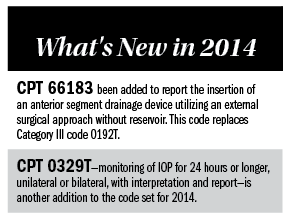Article
New CPT codes evolve for glaucoma services
The 2014 version of Current Procedural Terminology contains two important changes for ophthalmologists who provide glaucoma services.
Take-home
The 2014 version of Current Procedural Terminology contains two important changes for ophthalmologists who provide glaucoma services.

Dr. Freeman
coding.doc By L. Neal Freeman, MD, MBA
Ophthalmologists who provide glaucoma services should note two important changes-CPT 66183 and CPT 0329T-in the 2014 version of Current Procedural Terminology (CPT).
Examining these changes is especially instructive. There are implications regarding different categories of CPT codes, and the variations between diagnostic and therapeutic services.
CPT 66183 been added to report the insertion of an anterior segment drainage device utilizing an external surgical approach without reservoir. This code replaces Category III code 0192T. This is not an addition of a previously unrecognized service, but conversion of a Category III CPT code to a Category I CPT code. Alcon Laboratories has instructed practitioners utilizing its glaucoma filtration device (Ex-Press) to report under CPT 66183.
The conversion to CPT Category I implies the service is performed by many physicians or other qualified health-care professionals across the United States. Also, there must be literature support of clinical efficacy.
The elevation to Category I status means that relative value units (RVUs) are now assigned by Medicare. CPT 66183 carries a total of 30.42 RVUs when performed in a facility setting. Although the legislative environment has been somewhat volatile recently regarding payment levels, it is reasonable to estimate a Medicare allowable of $1,090 for this service based on RVUs. A 90-day global period has been assigned.
Unlike the case for trabeculectomy codes 66170 and 66172-which explicitly distinguish between cases performed in the absence and presence of previous surgery respectively-CPT 66183 is appropriate coding for the service regardless of the previous surgical status of the eye. Modifier -22, Increased Procedural Services, may be added if documentation reflects substantially greater work than typically required. Additional payment may ensue depending on the particular payer.
The AMA’s Relative Value Scale Update Committee (RUC) reviews selected codes on an ongoing basis for possible misevaluation. CPT 66183 has been placed on a list due to the novel type of service being offered. The RUC may come back to modify the value of 66183 relative to other codes in the future.
As a Category III code, external placement of an anterior segment drainage device had minimal or no payment rate standardization. In these situations, payers often look to similar services as benchmarks regarding payment rates.

About CPT 0329T
CPT 0329T-monitoring of IOP for 24 hours or longer, unilateral or bilateral, with interpretation and report-is another addition to the code set for 2014. It is a Category III code since it is considered as emerging technology. Category III status is often used when tracking of a service is desired. This becomes highly relevant if the code eventually comes up for “promotion” to Category I.
A number of new devices are designed to allow continuous IOP monitoring, similar to the concept of continuous heart rhythm monitoring with a Holter monitor. In contrast, serial tonometry is traditional measurement of IOP at multiple times during the day, typically accomplished with a lengthy office visit by the patient.
CPT 0329T should be used when a monitoring device is fitted to the patient for continuous monitoring over a full day, instead of special ophthalmological service code CPT 92100 (Serial tonometry with multiple measurements of IOP over an extended time). A new parenthetical has been added after 92100 indicating appropriate use of 0329T.
Most category III codes are not covered by many or all payers as they are considered unproven. Frequently, coverage may be considered by the payer on a case-by-case basis. There may be specific guidelines from the payer that indicate if coverage is available. For example, Aetna’s Clinical Policy Bulletin, “Glaucoma Testing” (http://www.aetna.com/cpb/medical/data/600_699/0622.html) indicates 0329T is not a covered service.
Ophthalmologists who intend to provide a Category III service to a Medicare beneficiary should strongly consider asking the patient to sign an Advance Beneficiary Notice of Noncoverage (ABN). Physicians may collect upfront from the patient, but must refund the payment if the carrier reimburses for the service.
Depending on the contract, a form similar to the Medicare ABN may be appropriate for use in patients covered by a private plan.
CPT is an evolving system and annual changes may be frequent. This is yet another reason for ophthalmologists to keep coding information up to date and to educate themselves in this area frequently.
L. Neal Freeman, MD, MBA, is president and founder of CPR Analysts, Melbourne, FL (http://www.cpranalysts.com/). He advises physicians nationally on coding, reimbursement, and practice management. Dr. Freeman is a practicing ophthalmic plastic surgeon and a certified specialist in physician coding. Readers may contact Dr. Freeman at nfreeman@cpranalysts.com.
CPT codes, descriptions, and other data only are copyright 2014 American Medical Association (AMA). All Rights Reserved (or such other date of publication of CPT). CPT is a trademark of the AMA.
Subscribe to Ophthalmology Times to receive the latest clinical news and updates for ophthalmologists.
Newsletter
Don’t miss out—get Ophthalmology Times updates on the latest clinical advancements and expert interviews, straight to your inbox.




